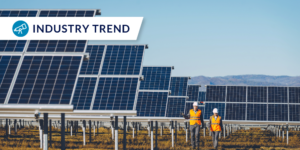
Despite the current national solar boom, one green energy firm’s bankruptcy has put dozens of contractors at risk, highlighting the hazards of the still-emerging industry.
Earlier this month, Indiana’s Midwest Wind and Solar, LLC filed Chapter 7 bankruptcy. With no opportunity to restructure, the company will be forced to liquidate its assets in order to pay back its creditors.
It’s unclear exactly what’s on Midwest’s books — assets are simply indicated to be in the $100,000–$500,000 range — but it’s obvious that liquidation will hardly make up for the $1 million–$10 million liabilities listed in Midwest’s bankruptcy filings.
29 creditors — all of which are unsecured — are named in the fillings, although the documents suggest there could be as many as 99 creditors in total.
Unfortunately, the unsecured nature of the creditors’ debt makes it difficult to envision a scenario in which all parties are able to collect payment in full.
Levelset’s coverage of the recent solar boom has shown that, though not without challenges, solar energy adoption has largely been accelerated by the global pandemic.
From April to July of 2020, Americans spent $6 billion more on home energy than they would have in “normal” times as the country adjusted to working from home. Stimulus checks certainly helped, but the extra spending money also boosted demand for home improvement projects and encouraged the spirit of DIY.
Solar power proved to be an attractive solution to the country’s energy needs, offering a greener and potentially cheaper alternative source of energy. 2020 saw record levels of solar energy installation, adding 144GW of solar power to the nation’s grid.
2021 continued this trend, increasing solar installation a further 33% to an estimated 191GW.
The US Department of Energy estimates that by 2035, under current initiatives, 40% of the country’s power will be solar — enough to power all American homes and employ up to 1.5 million people.
The solar boom is not expected to slow any time soon. In order to meet these goals, yearly solar installations will need to be quadrupled, and contractors will likely benefit from the industry’s growth.
Can too much growth be a bad thing?
Although some solar firms have seen profits increase significantly in recent years, it is important to consider whether such volatile growth is sustainable.
Solar installation is expensive, and firms can easily be stretched thin by high upfront costs due to expansion.
Levelset has covered a number of bankruptcies in the solar industry, and Midwest Wind and Solar’s collapse may represent the latest casualty of the still-budding industry.
While the Biden administration’s emphasis on expanding green energy will likely bring improved stability to the solar industry, it is important for contractors to be aware of the risks that may come from taking on projects associated with high-growth solar firms.
Unfortunately for the 29 plus creditors listed in Midwest’s bankruptcy filings, their unsecured debt may not be recoverable once liquidated assets have dried up.
With 97% of construction professionals experiencing stress from payment and cash flow issues, it’s essential that contractors take measures to secure their right to payment and protect their cash flow.